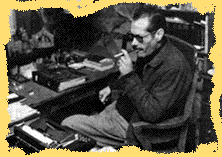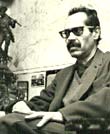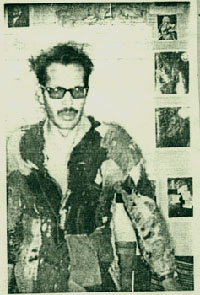

JACKET INTERVIEW
Forrest Gander and Kent Johnson
in conversation with
Nicomedes Suárez-Araúz
In Search of the Night: on translating Jaime Saenz: an Interview with his translators, Kent Johnson and Forrest Gander
This piece is about 4 printed pages long
Jaime Saenz is arguably the greatest Bolivian writer of the twentieth century. His poetry is apocalyptic, transcendent, hallucinatory, brilliant — and, until recently, available only in Spanish. An unusual man, Saenz lived his whole life in La Paz, Bolivia, seldom venturing far from the city and its indigenous culture that feature so prominently in his writings. He sought God in unlikely places: slum taverns, alcoholic excess, the street. Saenz was nocturnal. He once stole a leg from a cadaver and hid it under his bed. On his wedding night he brought home a panther.
Forrest Gander and Kent Johnson’s translations of Saenz’s work have garnered much-deserved attention and acclaim. Recently they translated his masterpiece, ‘The Night’, Saenz’s most famous poem and the last he wrote before his death in 1986. This is the first time the poem has been translated into English. The Night, poems by Jaime Saenz, is published by Princeton University Press.

Jaime Saenz
‘The continuing Gander/Johnson excavation of Jaime Saenz is by far the most interesting project of Spanish poetry translation in many years. They have taken a poet who was completely unknown in the U.S. and put him on the map as someone who must be read. The Night, this hallucinated journey into the hell of the self, may be Saenz’s greatest work, and it may well be that the most original version of the poem is its English translation.’ — Eliot Weinberger.
For more information about Saenz, see http://press.princeton.edu/titles/8377.html
Forrest Gander [FG]: Although Kent brought Saenz to my attention, I myself discovered Kent, and so I feel largely responsible for what came to be our mutual fascination, though of course Kent hogs all the credit.
Kent Johnson [KJ]: I see that this interview has gotten off to a classically predictable start: The once-faithful amanuensis rebelling, with affected insouciance, against his master…

Jaime Saenz
But seriously, the circumstances of initial discovery are rather banal: I was a grad student at the University of Wisconsin/Milwaukee, early 1980s, browsing books in the Hispanic Literature section, and thumbing through a Spanish-language anthology of twentieth-century Latin American poetry. There I came across a section from To Cross This Distance and a few poems from As the Comet Passes. I was struck by the poems, they seemed so unusual, a strangeness there I hadn’t encountered before. But there were other things to do, of course, so I put the book back, and years went by, until one day, mid-90s, I decided that since I so often thought back to those poems of Saenz, wondering always what else there was, I should order his big Obra Poética through inter-library loan. After that, there was no turning back. And as soon as I decided I needed to translate him, I knew I would need a poet-collaborator whose resources in English were greater than my own. And to translation’s good fortune, Forrest said yes.
FG: We were magnetized to the way Saenz creates a meditative aura, for one thing. He often uses colloquial language, but he can shift the tone higher without rupturing the poem’s characteristic texture. He’s brilliant in these shifts of tone and rhythm and diction. Reading a passage by Saenz, we might be lulled by a list or by the familiar language of daily conversation, a sentence running along through various clauses, and then suddenly, Saenz will invest the phrasing with a heightened formality and mystery. The tone expands like a sponge and resonates with potential meanings, with intimation. It’s often as though a vast, unexpected realm opens up behind the words. For instance, within a few lines in the first part of The Night, Saenz shifts gears from the easy-going rhythm and undemanding grammar of:
El día es para respirar, para saludar, para recorrer muebles
y cambiar de sitio algunas cosas;
el día es de oficinas, de dimes y diretes y de gente buena
y optimista
The day is for breathing, for hellos, for hauling furniture around and rearranging details;
the day of offices, of tell-me’s and tell-you’s and of placid optimists,
to the abrupt:
El día es la superficie del mundo
La noche no.
La noche es la noche.
The day is the carapace of the world.
Not the night.
The night is the night.
and then to the numinous:
Por eso la luz de la noche es una luz aparte… .
So the night’s light is a light apart...
Likewise, Saenz is fond of hammering terms against each other and then breaking through the frame that the terms construct. He does this, for instance, at the beginning of section 8 in The Night when he begins:
Cuando hablo de jứbilo y de angustia, me refiero al aprendizaje;
y me refiero al aprendizaje del conocimiento.
En realidad, me refiero al aprendizaje del conocimiento
When I speak of jubilation and anguish, I mean apprenticeship;
and I mean intimate knowledge.
Actually, I mean apprenticeship to intimate knowledge
The paradoxical and meditative eddy sometimes calls to mind, for us, the work of the French poet Edmond Jabès. Saenz’s focus on the body brings to mind Whitman, albeit Saenz’s relationship with the body is even more mystical. But for all three of them, the encounter with the world takes place through the body. Jabès says in an interview: “I believe a writer works with his body, and the book is above all the book of your body.”

Saenz wearing a beggar's coat
KJ: All this is well said, and I concur entirely. I’d add that we are awed, too (and increasingly so, the longer we spend with Saenz), by his overall musical, symphonic sense of composition, by the architectonic ways he builds his longer poems. What Forrest says above about the complex structures of tone and pitch within passages applies as well across the greater composition: that is, Saenz writes in “movements,” magisterially sequencing moods, registers, and themes in sublime, stunning ways. His two most famous book-length poems, To Cross This Distance, and The Night, are excellent examples of this. He is a composer on grand scales.
FG: Certainly so. Both Saenz’s translators went to public schools (state schools) and were raised in middle class families and felt an immediate rapport with Saenz’s contempt for the power elite, for high society, a contempt he elicits hilariously in section 5 of To Cross This Distance:
They grow thoughtful reading the papers, they sigh with
calculated restraint, they cough with self-satisfaction and fall
ill every now and then, as prescribed by rituals of decorum…
But we also fell for the amorous side of Saenz. He is a wooer of readers. His love for the city of La Paz, mixed with his mystico-erotic address to his beloved, mixed with his constant foreplay with death, affected us. His eros translated easily into our own.
KJ: Agreed, though I’d say (and I know Forrest agrees with me) that Saenz goes beyond being in mere “foreplay” with Death. I mean, there is certainly that sense of play, yes, and at a variety of conceptual levels. But I’d say that beneath this, Saenz is in something like a sadomasochistic relationship of bondage with Death--or at least working out, via elaborate role play, a fantasy of such… Saenz is indeed very playful, erotic, often knee-slapping funny, but he’s writing, always, even in those gorgeous “amorous” sections, out of a darker, total submission to his Master. A bit like Dickinson, to my mind, in that sense… And this is one of the main reasons his poetry is so strange and brave and singular. Don’t you think?
FG: This was indeed difficult for us. It helped a great deal to go down to Bolivia, to speak with people who knew Saenz, as he would say, intimately. Both his syntax and his imagery can be just downright weird at times. Even just the first line of La Noche gave us fits:
La noche con unos cuernos que se mueven a lo lejos…
The night, its feelers twitching in the distance
Are we supposed to see a night with antlers, is it a cuckolded night, are the cuernos to be imagined as tree branches? Or when Saenz writes:
la noche se difunde con invisibles chispas que
a ratos relampaguean en los ojos y en los botones de
algunos vecinos que todavía no se han acostado
the night broadcasts itself in invisible sparks that flicker here, now there in the eyes and buttons of neighbors not yet taken by sleep.
in what sense is he using the word botones, which can be translated into English in various ways (ie. buttons, buds, badges, knobs, crankpins, even bellboys or pages). With regard to that specific peculiarity of expression in Saenz, you have asked a trick question, of course. Because while the oddness, the otherness is, in a sense regional, is very specific to the place where Saenz lived almost all of his life, it is not a region that anyone else can visit. Because for Saenz, place and person are coexistent. The language Saenz uses is a language that comes from the La Paz that Saenz and only Saenz could know. The only tour guide to that place is Saenz himself. His poetry is the map of that place where soul is identical with city.
KJ: Forrest has quoted here, almost verbatim, from a long email I sent him years ago, as I tried to convince him to join me, as my paid assistant, in the Saenz translation. But he left off my two concluding sentences to the passage, which read, “But it is precisely through this insistent particularity, at lexical and syntactic vectors, that his language effloresces into the universal, the poetry becoming some huge, weird, metaphysical thorax flying on the fragile wings of a cultural and private eccentricity. In this sense, there is no one like him since Vallejo, who happened to be his big hero.”
I reminded Forrest of this metamorphic analogy, by the way, when he was panicking over that first line of The Night, wondering how on earth the Night could have antlers. “‘Cuernos, cuernos’… How the f… could the Night have antlers, like a deer’s?” he cried. “What about ‘feelers’,” I gently said, “like an insect’s?”
*
FG: Sadly, I am obliged to point out here, for innocent readers, that Kent was not named for the diligent and trustworthy character in King Lear. That translating and traveling together, we got through The Night at all is a miracle, un verdadero milagro. And as Jaime Saenz reminds us, such miracles are due entirely to alcohol: ‘es obra exclusiva de alcohol.’
Forrest Gander’s author notes page gives more recent information on his work, as does Kent Johnson’s author notes page on his.
| |

|
|